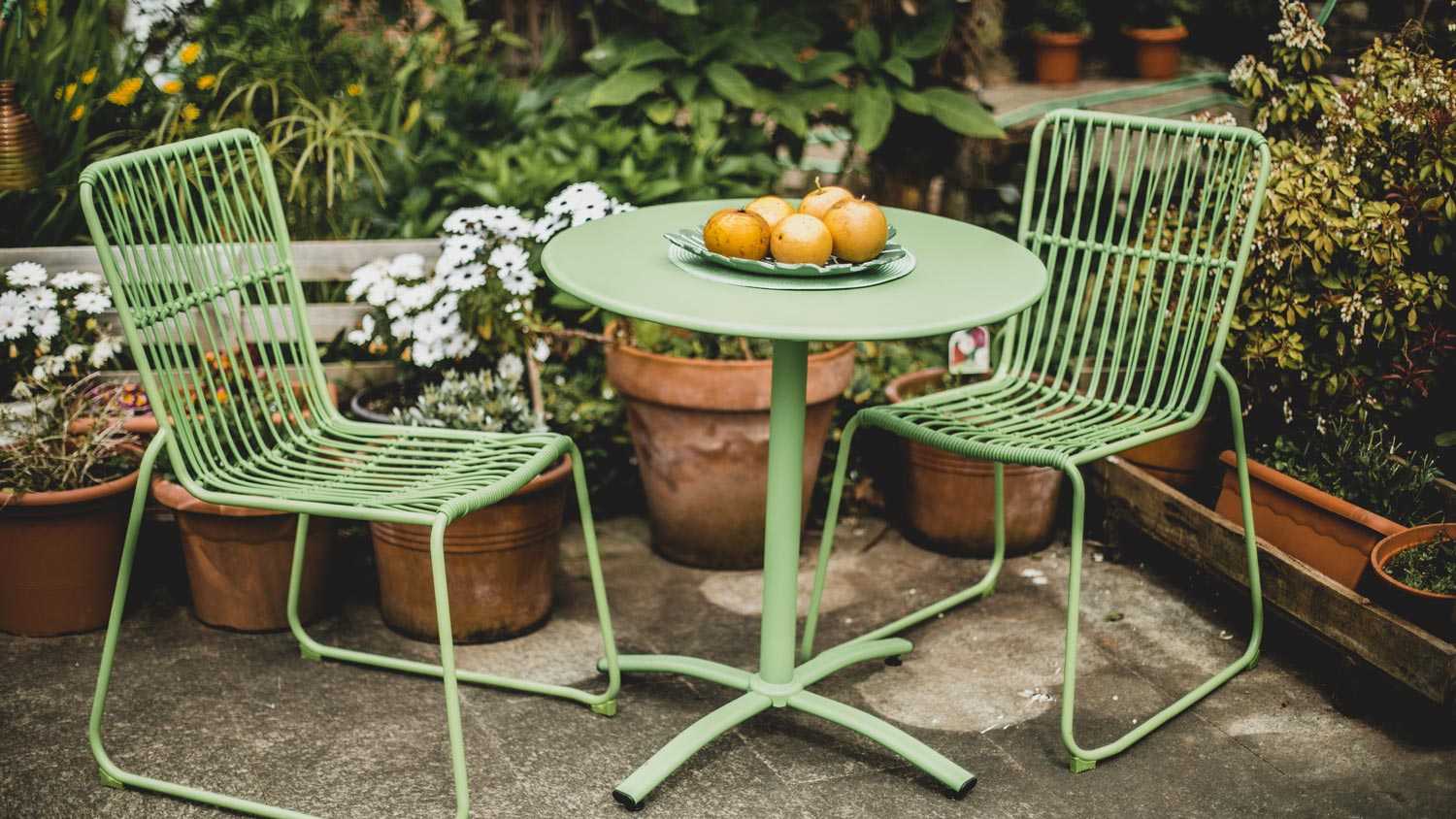11 Tips to Get Your Patio Furniture Sparkling for Spring
Be ready for al fresco dining by dusting down your patio set


When the warm weather is just around the corner, get ready to set up your space for outdoor entertaining again. To make an impression, you’ll want to polish up and protect your patio furniture so it looks its best and will for years to come.
Outdoor furniture can take a beating when exposed to the elements, birds and other wildlife, especially when it’s neglected over the winter. Here are our top tips for spring cleaning patio furniture, no matter the material.
1. Don’t Blast With a Pressure Washer
If you’re already cleaning your deck with the pressure washer, it’s tempting to give your deck furniture a quick once-over too. However, the force of the stream of water can cause damage and affect the integrity of the material, especially for woods like teak. If you do use it, turn the pressure down, clean in the direction of the grain, and keep the jets away from delicate furniture joints. Getting out the bucket, sponge, and hose is a safer option.
2. Use Your Leaf Blower to Remove Debris
Before you get in there with a rag and a soft-bristle brush, if you have a leaf blower, you might want to give your furniture a once-over with it. It lifts away cobwebs, insects, leaves, and other debris that gathers in hard-to-reach places, especially on material like wicker. Canned air, used to clean keyboards, is a handy alternative.
3. Use Warm (Not Cold!) Water

Don’t be tempted to fill up the cleaning bucket with water from the outdoor hose. You’ll need warm water to penetrate through grease and grime. Boiling water is also a no-go—it can damage and discolor wood, wicker, and outdoor fabrics.
4. Stick With Simple Cleaning Solutions
Mixing dish soap into a bucket of warm water works wonders when cleaning down your garden furniture. For stubborn dirt or stains, let the soap solution sit for up to 15 minutes, scrub off with a soft-bristled brush, then rinse with clean, warm water.
"A dish soap solution can be utilized to safely clean all materials of outdoor furniture, including wood, metal, and plastic” said Asya Biddle, Angi Expert Review Board member and manager of The Dustbusters, a family-owned and operated janitorial company in Williamsport, PA. “It is also cost effective and eco-friendly."
For plastics and unstained wood, if there are tougher stains or mildew, use an equal mix of bleach and water. Or, a gentler option would be to use a mix of white vinegar, baking soda, and warm water.
5. Remove Rust From Metal Furniture First
Scrub off any light rust from wrought iron furniture using a bit of elbow grease and sandpaper, a wire brush, or steel wool. Start with a coarser tool and finish with a light-grit sandpaper for a smooth, neat finish. Use a rust preventative, like WD-40, to help prevent more rust from forming and lubricate joints. Pay close attention to the furniture joints, as rust is more likely to develop here.
If rust or other wear and tear cause major problems for the joints or other furniture parts, consider calling in a patio furniture repair company near you.
6. Avoid Bleach on Metal Furniture
Stick with gentle cleansers for furniture made from metals like stainless steel or copper. Bleach can leave stains and corrode these materials. It can also set rust stains and make them more tricky to remove.
7. Get the Brushes Out
Using a soft-bristle brush to remove stubborn dirt is a good idea for any garden furniture. It’s especially useful for wicker. The plaited material is tough to clean thoroughly with just sponges or rags. Using a toothbrush can help reach in between the tight weaves, especially because mildew is more likely to gather in these moisture-trapping places.
8. Don’t Leave Cleaners on Wicker Furniture Too Long
Although leaving cleaners on the furniture helps to dislodge stubborn grime, you don’t want to leave water and cleaners soaking on wicker furniture. Extended saturation can warp the furniture. Use a damp cloth rather than a hose to rinse it down too.
9. Steer Clear of Abrasives

Plastic, softwood, and wicker are more likely to mark if you use an overly hard brush or abrasive cleaning products. Stick with damp cloths, sponges, and gentle cleaning solutions if you have concerns.
10. Scrub Softwoods in the Direction of the Grain
Hardwoods like teak are more durable, but with softwoods, like pine, if you are scrubbing with a bristle brush, do this in the direction of the wood grain. This minimizes the chance of a scrub pattern forming.
11. Don’t Forget to Clean the Outdoor Upholstery
Seat and umbrella covers and cushions come in a variety of fabrics. Usually, these are hard-wearing, weatherproof options like acrylic, vinyl, or polyester. To clean:
Follow the manufacturer's care instructions.
If machine washing isn’t possible, stick with a soapy, warm water mix.
Try using a water and white vinegar mix to scrub off any mildew.
Make sure cushions are fully dry before putting covers back on.
Strong cleaning products could cause staining or remove weatherproof properties. Even with mild cleaning products, you may need to re-treat with a fabric guard suitable for the material type.





- 26 House Cleaning Tips to Elevate Your Cleaning Game
- How to Paint Furniture to Get Beautiful, Long-Lasting Results
- 11 Tips for Furnishing Your Patio to Make It Fresh, Fun, and Inviting
- How to Fix Water-Damaged Wood Furniture
- 10 Tips to Remove Bird Poop Stains on Outdoor Furniture
- 6 DIY Tips and Tricks for Safely Cleaning Your Upholstery
- How to Clean the Exterior of Your House Like a Pro
- These Are the Best Types of Paint for Outdoor Furniture
- 11 Cleaning Hacks Everyone Should Know
- The Ultimate Room-by-Room Spring Cleaning Checklist











